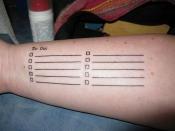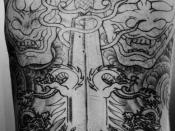�PAGE � �PAGE �1� History of Body Art
HISTORY OF BODY ART
Lisa Miller
Effective Essay Writing
Professor Dr. Steve Lazarre
April 04, 2010�
The history of body art is ritualistic and has a deep and rich history because tattoos and body piercings have been in human culture for thousands of years. However, body art has a history that has evolved into mainstream society. The word "tattoo" originates from the Tahitian word tattau, meaning "to mark".
Historical research has shown Egyptians used tattoos to symbolize fertility and nobility as far back as 4000 BC. Body piercing also has a deep and rich history. Piercings were being used as a symbol of royalty and courage. Also, piercings and tattoos have been used in initiation rites in hunting and gathering societies.
In 1992, the four thousand year old body of a tattooed man was discovered in a glacier on the Austrian border.
This discovery proves the long history of body art, not just as aesthetics but as a rich part of certain cultures.
Until the last few decades, mainstream society has recognized body art as a reflection of deviancy. Body art was commonly associated with criminality, mental illness and deviant subculture groups. Tattoos marked affiliation for prisoners and gang members. Also, heavily tattooed Polynesians were displayed as "savages".
While scholars have observed tattoos' rise in cultural popularity, so far tattoo art is still described as "quasi-legitimate". They have completely avoided examining the process of how tattoo art has undergone a transformation by cultural elites.
Research shows that colonialism has had a major impact on the modern history of tattooing in the West. However, research also indicates that body art was shown in Europe before it was "discovered" in the South Pacific during the seventeenth and eighteenth centuries. Tattoos were believed to be associated with the worlds of carnivals and sideshows.
As per research done by Richard S. Post, in an article from 1968 he states that all motives for getting a tattoo are reduced into one of three deviant sexual categories: "the exhibitionist element, the masochistic element and the sex symbol element". There are also several cases in which claims were made that there was a link between tattoos and homosexual tendencies.
There have also been studies that attempt to prove that tattoos and piercings are indicative of the psychology of "self-mutilation, defiance, independence and belonging, as for example in prison or gang cultures."
However, the tattoo community presents a cultural history, focusing on how tattoos' meanings have changed since the 1980's, making it more attractive to the middle classes. The discourse of deviance is an important factor in presenting body art as a legitimate art form. Tattoo, a previously ignored practice, is in the process of undergoing a "cultural re-inscription." Whether or not tattoos will have a substantial influence on the twenty first century is something that still remains to be seen.
In today's industrialized cultures, tattoos and piercings are a popular art form shared by people of all ages. At one time, tattoos were looked at as signs of rebellion by many. Eventually, tattoos overcame the stereotype of being rough, causing people today to adopt this new source of culture, and tattooing became a form of body art which created the trend we know today.
There are many reasons a person may choose to get a tattoo. Some of the most popularized reasons are: to cover old scars, memorials, self-expression and peer pressure. Appeal and peer pressure have a lot to do with why tattoos are so popular. However, not everyone wants to get a tattoo to "fit in"; In other words, they have their own reasons behind wanting to get a tattoo. Also, self expression as a reason for a tattoo is to feel better about yourself and to portray who you are on your body.
While piercings and tattoos are popular, both present definite health risks. Tattoos can lead to infectious diseases, such as hepatitis B and C. Also, in theory, HIV can be contracted when proper sterilization and safety procedures are not followed. There is also the risk of having an allergic reaction to certain inks that may be used. Body piercings also presents the risk of hepatitis B and C, tetanus and skin allergies reacting to the type of metal in the jewelry used. A recent Mayo Clinic study reported that seventeen percent of college students with piercings suffered a medical complication.
Body piercing and tattooing are unregulated in most United States and even illegal in some. The American Dental Association (ADA) opposes oral piercings, such as tongue, cheek and lip. Also, the American Academy of Dermatology is against all forms of body piercing, except the ear lobes.
The most popular places for piercings on the human body range from the ear, nasal septum, eyebrow, tongue, navel, labia, cheek and penis. Piercing is performed quickly and usually with a hollow point, crescent shaped needle, varying from six to eighteen gauge needles. Piercings are typically performed in tattoo parlors.
Tattoos are achieved when an electric needle injects colored pigment into tiny deep holes made in the skin. In recent years, the ancient art of Mehndi, or temporary tattooing of the skin with a paste made of henna, has become popular in America. Although seemingly safe because it does not pierce the skin, henna tattoos using black henna, "a paste containing parahenylenediamine", can actually be dangerous when absorbed into the skin.
Body art has not only risen in status to become moderately popularly acceptable, in some instances, body art has achieved an elevated degree of aesthetic value in modern society. The tattoo/deviance connection makes body art's cultural climb both a unique and significant event.
�
Kosut, Mary (2006) Mad Artists and Tattooed Perverts: Deviant Discourse and the Social Construction of Cultural Categories. Deviant Behavior, 27, 73-95. Retrieved from http://www.hawaii.edu/hivandaids/Mad_Artists_and_Tattooed_Perverts__Deviant_Discourse_and_the_Social_Construction_of_Cultural_Categories.pdf
Holmes, Dwana Jenia (2007) Tattoos on the Uprise in Today's Culture. Associated Content. Retrieved from http://www.associatedcontent.com/article/188259/why_are_tattoos_popular
Abbasi, Kamran (2001) Body Piercing. British Medical Journal , 936 Retrieved from http://health.stateuniversity.com/pages/1186/Piercing-Tattoos.html





